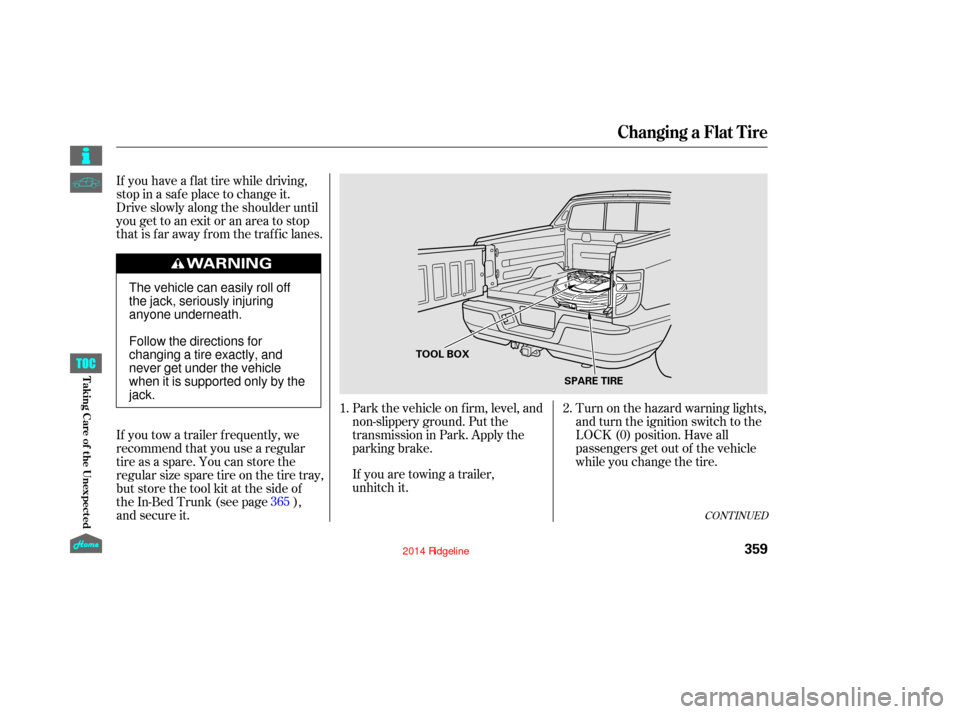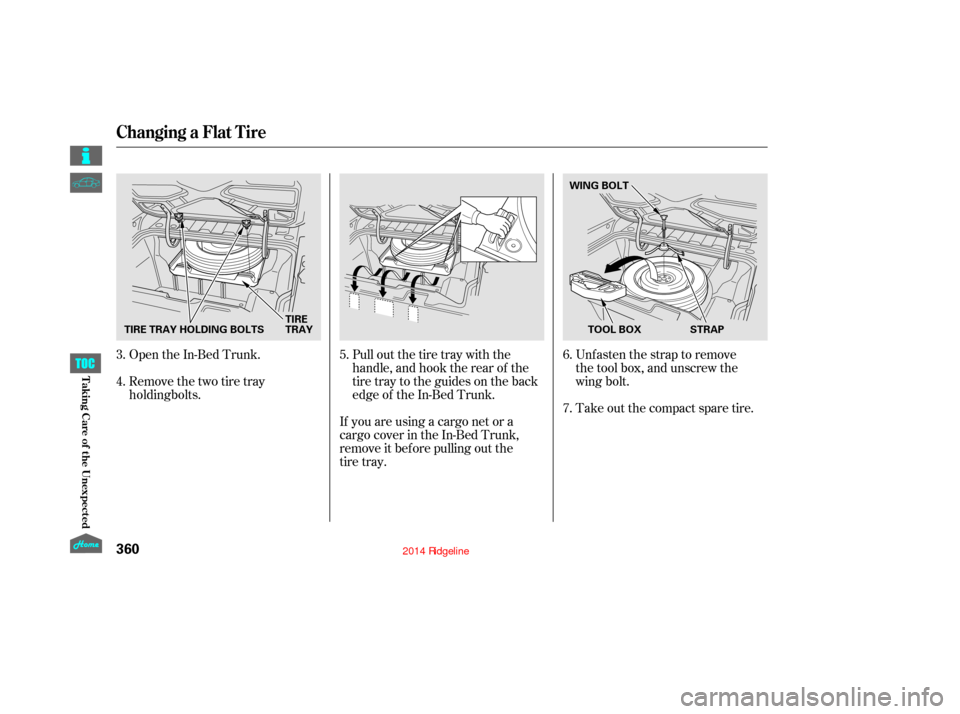2014 HONDA RIDGELINE spare tire
[x] Cancel search: spare tirePage 306 of 422

The added weight, length, and
height of a trailer will affect your
vehicle’s handling and performance,
so driving with a trailer requires
some special driving skills
and techniques.
The vehicle has been properly
serviced, and the tires, brakes,
suspension, cooling system,
and lights are in good
operating condition.
The trailer has been properly
serviced and is in good condition.
All weights and loads are
within limits.
Thehitch,safetychains,andany
other attachments are secure.
Allitemsonandinthetrailerare
properly secured and cannot shif t
while you drive.
When preparing to tow, and
before driving away, be sure to
check the following:
Towing performance can be
affected by high altitude, high
temperature, or when climbing
steep grades. Therefore,
premium fuel (premium
unleaded gasoline
with pump octane number
of 91 or higher)
is recommended when
towing more than
3,500 lbs (1,590 kg). The trailer tires and spare are
in good condition and
inflated as recommended by
the trailer maker. Your vehicle tires and spare
are in good condition and
properly inflated. The lights and brakes on your
vehicle and the trailer are
working properly.Foryoursafetyandthesafetyof
others,taketimetopracticedriving
maneuvers bef ore heading f or the
open road, and f ollow the guidelines
on thef ollowing page.
CONT INUED
Driving Saf ely With a T railer
Pre-T ow Checklist
Towing a Trailer
301
12/08/09 16:38:56 31SJC670_308
Driving
Page 351 of 422

Keeping the tires properly inf lated
provides the best combination of
handling, tread lif e, and riding
comf ort.Underinf lated tires wear unevenly,
adversely affect handling and fuel
economy, and are more likely to
fail from being overheated.
Overinf lated tires can make your
vehicleridemoreharshly,are
more prone to damage f rom road
hazards, and wear unevenly. Even though your vehicle is
equipped with TPMS, we
recommend that you visually check
your tires every day. If you think a
tire might be low, check it
immediately with a tire gauge.
Use a gauge to measure the air
pressure in each tire at least once a
month. Even tires that are in good
condition may lose 1 to 2 psi (10 to
20 kPa, 0.1 to 0.2 kgf /cm ) per
month. Remember to check the
sparetireatthesametime.
Check the air pressures when the
tires are cold. This means the
vehicle has been parked f or at least 3
hours, or driven less than 1 mile (1.6
km). Add or release air, if needed, to
match the recommended cold tire
pressures on page . If you check air pressures when the
tires are hot (driven for several
miles/kilometers), you will see
readings 4 to 6 psi (30 to 40 kPa, 0.
3 to 0.4 kgf/cm ) higher than the
cold readings. This is normal.
Do not let air out to match the
recommended cold air pressure.
The tire will be underinflated.
You should get your own tire
pressure gauge and use it whenever
you check your tire pressures. This
will make it easier for you to tell if a
pressure loss is due to a tire
problem and not due to a
variation between gauges.
While tubeless tires have some
ability to self-seal if they are
punctured, you should look
closely for punctures if a tire
starts losing pressure.
The tire pressure monitoring system
(TPMS) warns you when a tire
pressure is low. See page or
f or more inf ormation. 276
279
347
Inf lation Guidelines
Tires
346
12/08/09 16:44:49 31SJC670_353
Maint enance
Page 352 of 422

Never use a puncture-repairing agent
in a f lat tire. If used, you will have to
replace the tire pressure sensor.
Havetheflattirerepairedbyyour
dealer as soon as possible.
The following chart shows the
recommended cold tire pressures
for most normal and high-speed
driving conditions.Your tires have wear indicators
molded into the tread. When the
tread wears down, you will see a 1/2
inch (12.7 mm) wide band across the
tread. This shows there is less than
1/16 inch (1.6 mm) of tread lef t on
the tire.
A tire this worn gives very little
traction on wet roads. You should
replace the tire if you can see three
or more tread wear indicators.
Thecompactsparetirepressureis:
Excessive tread wear. Cuts, splits, or cracks in the side
of the tire. Replace the tire if you
can see f abric or cord. Bumps or bulges in the tread or
side of the tire. Replace the tire if
youfindeitherof theseconditions.
Every time you check inf lation, you
should also examine the tires f or
damage, f oreign objects, and wear.
Youshouldlookfor: For additional inf ormation about
your tires, see page . For convenience, the recommended
tire sizes and cold tire pressures are
on a label on the driver’s doorjamb.
390
Tire Size Cold Tire Pressure
Tire Size Cold Tire PressureFront/Rear:
Front/Rear:
RTL, Touring, and Sport models
RT,RTS,DX,andVPmodels
Recommended Tire Pressures
Tire Inspection
Tires
347
INDICATOR LOCATION MARKS
TREAD WEAR INDICATORS60 psi (420 kPa , 4.2 kgf/cm)
P245/65R17 105T 32 psi (220 kPa , 2.2 kgf/cm
)
P245/60R18 104T 32 psi (220 kPa , 2.2 kgf/cm
)
12/08/09 16:45:08 31SJC670_354
Maint enance
Page 353 of 422

In addition to proper inf lation,
correct wheel alignment helps to
decrease tire wear. If you f ind a tire
is worn unevenly, have your dealer
check the wheel alignment.
Have your dealer check the tires if
you feel a consistent vibration while
driving. A tire should always be
rebalanced if it is removed from the
wheel. When you have new tires
installed, make sure they are
balanced. This increases riding
comfort and tire life. For best
results, have the installer perform a
dynamic balance.
The service lif e of your tires is
dependent on many f actors,
including, but not limited to, driving
habits, road conditions, vehicle
loading, inf lation pressure,
maintenance history, speed, and
environmental conditions (even
when the tires are not in use).
In addition to your regular
inspections and inf lation pressure
maintenance, it is recommended that
you have annual inspections
perf ormed once the tires reach f ive
years old. It is also recommended
that all tires, including the spare, be
removed from service after 10 years
from the date of manufacture,
regardless of their condition or state
of wear.
The last f our digits of the TIN (tire
identif ication number) are f ound on
the sidewall of the tire and indicate
the date of manufacture (See
on page ). To help increase tire lif e and
distribute wear more evenly, rotate
the tires according to the
maintenance messages displayed on
the inf ormation display or multi-
inf ormation display (depending on
models). Move the tires to the
positions shown in the diagram each
time they are rotated. If you
purchase directional tires, rotate
only f ront-to-back.
390 Tire Rotation
T ire Maintenance
Tire Service Lif e
Tire
Labeling
Tires
348
Front
(For Non-directional
Tires and Wheels) (For Directional
Tires and Wheels)Front
On vehicles with aluminum wheels,
improper wheel weights can damage
your vehicle’s aluminum wheels. Use
only Honda wheel weights f or
balancing.
12/08/09 16:45:17 31SJC670_355
Maint enance
Page 362 of 422

This section covers the more
common problems that motorists
experience with their vehicles. It
gives you inf ormation about how to
safely evaluate the problem and what
to do to correct it. If the problem has
stranded you on the side of the road,
you may be able to get going again.
If not, you will also f ind instructions
on getting your vehicle towed.......................
Compact Spare Tire .358
....................
Changing a Flat Tire .359
.............
If the Engine Won’t Start . 367
................................
Jump Starting .368
..............
If the Engine Overheats . 370
.........
Low Oil Pressure Indicator . 372
..........
Charging System Indicator . 372
.......
Malf unction Indicator Lamp . 373
...............
Brake System Indicator . 374
..............................................
Fuses .376
..............................
Fuse Locations .379
......................
Emergency Towing .381
..........
If Your Vehicle Gets Stuck . 381
Taking Care of the Unexpected
357
12/08/09 16:46:12 31SJC670_364
Page 363 of 422

Use the compact spare tire as a
temporary replacement only. Get
your regular tire repaired or replaced,
and put it back on your vehicle as
soon as you can.
Check the air pressure of the
compact spare tire every time you
check the other tires. It should be
inf lated to:
Follow these precautions:Replace the tire when you can see
the tread wear indicator bars. The
replacement tire should be the same
sizeanddesign,mountedonthe
same wheel. The spare tire is not
designed to be mounted on a regular
wheel, and the spare wheel is not
designed f or mounting a regular tire.
Never exceed 50 mph (80 km/h).
This tire gives a harsher ride and
less traction on some road
surf aces. Use greater caution
while driving.
Do not mount snow chains on a
compact spare. Do not use your compact spare
tire on another vehicle unless it is
thesamemakeandmodel.
The low tire pressure indicator
comes on and stays on af ter you
replace the flat tire with the compact
spare tire. Af ter several miles
(kilometers) driving with the
compact spare tire, the TPMS
indicator comes on and the low tire
pressure indicator goes of f .
After the flat tire is replaced with the
spare tire, the low tire pressure/
TPMS indicator stays on. After
several miles (kilometers) driving
with the spare, this indicator begins
to f lash, then stays on again. You will
also see a ‘‘CHECK TPMS
SYSTEM’’ message on the multi-
inf ormation display (see page ). 282
On models without navigation system
On models with navigation system
Compact Spare Tire
358
INDICATOR LOCATION MARK
TREAD WEAR INDICATOR BAR
60 psi (420 kPa , 4.2 kgf/cm)
12/08/09 16:46:20 31SJC670_365
T aking Care of t he Unexpect ed
Page 364 of 422

Turn on the hazard warning lights,
and turn the ignition switch to the
LOCK (0) position. Have all
passengers get out of the vehicle
while you change the tire.
Park the vehicle on f irm, level, and
non-slippery ground. Put the
transmission in Park. Apply the
parking brake.
If you are towing a trailer,
unhitch it.
If you have a f lat tire while driving,
stop in a saf e place to change it.
Drive slowly along the shoulder until
you get to an exit or an area to stop
that is far away from the traffic lanes.
If you tow a trailer f requently, we
recommend that you use a regular
tire as a spare. You can store the
regular size spare tire on the tire tray,
but store the tool kit at the side of
the In-Bed Trunk (see page ),
and secure it.
2.
1.
365
CONT INUED
Changing a Flat Tire
T aking Care of t he Unexpect ed
359
TOOL BOX SPARE TIRE
The vehicle can easily roll off
the jack, seriously injuring
anyone underneath.
Follow the directions for
changing a tire exactly, and
never get under the vehicle
when it is supported only by the
jack.
12/08/09 16:46:27 31SJC670_366
Page 365 of 422

Open the In-Bed Trunk.
Remove the two tire trayPull out the tire tray with the
handle, and hook the rear of the
tire tray to the guides on the back
edge of the In-Bed Trunk.Unfasten the strap to remove
the tool box, and unscrew the
wing bolt.
Takeoutthecompactsparetire.
If you are using a cargo net or a
cargo cover in the In-Bed Trunk,
remove it before pulling out the
tire tray.
4. 3.
5.6.
7.
Changing a Flat Tire
360
WING BOLT
TOOL BOX STRAP
TIRE
TRAY
TIRE TRAY HOLDING BOLTS
12/08/09 16:46:36 31SJC670_367
T aking Care of t he Unexpect ed
holding bolts.